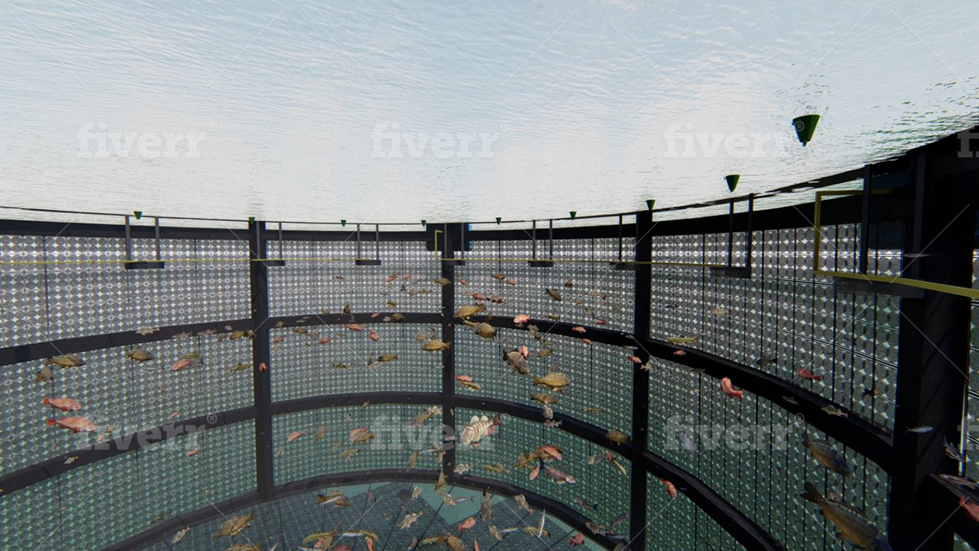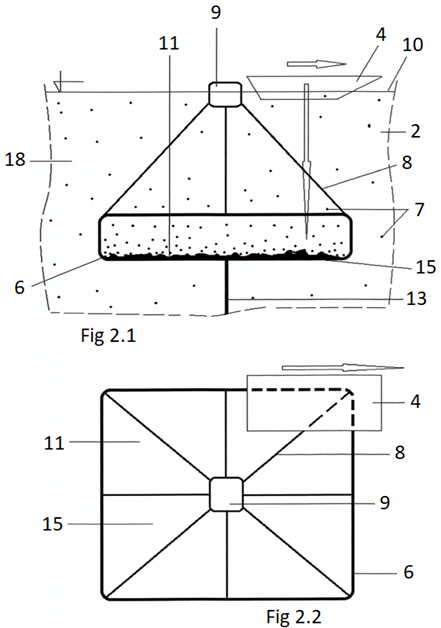Fish feeding platform
In this case, the open sea, accumulation or part of the river along the coast can be used for intensive fish farming. In the natural pond formed this way, new feeders would be used, platforms located below the water level that would enable automatic fish feeding.
The current inland fishponds would get a new feeding platform that would ensure that the fish are regularly fed on their own. Food would be consumed 100% and fish would be fed when it suits them.
With a regular and moderate feeding, fish does not create excess fat deposits, unlike today’s intensive fish farming, where the consumption of food is increased, which also creates an excess of fat deposits in fish. Current feeders usually throw granules into the water when the food ends up partly at the bottom of the pond, where it remains trapped in the mud underutilized.
The feeder would be periodically supplied with food by bigger or smaller boats, depending on the size and type of pond. Feeders would be large or small in size, different types of construction with the use of new solutions. With larger feeders, the fish would enter the platform, which ensures freedom and less stress for the fish. With this way of eating, the fish would not lose its weight, and the quality of the meat would be similar to the fish caught in its natural habitat.
A side view of parts of a feeder 6 for fish 7 in accordance with the present invention and for the purpose of self-serving fish 7 with food is shown. Feeder 6 is buoy 9 positioned at water level 10, attached to the corresponding cables 8. Cables 8 connect the feeder platform 11 to the buoy 9. Feeder platform 11 is positioned for the bottom by means of anchors 13. Feeder 6 is made as a tub, provided with the necessary structural elements.
The platform of the feeder 11 is placed at a suitable depth for feeding the fish 7, below the water level 10 so that the fish 7 can enter and exit it freely. The feeder platform 11 on the underside and side is made of perforated canvas. If necessary, the food is delivered by vessel 4 and stored in buoy 9. The dimensions of one feeder 6 can be from 0.1 m² to 100 m², where the size depends on the purpose and type of pond.

The feeder platform is made of perforated canvas or tub-shaped net. It is reinforced around the perimeter with cables with spans or other constructive solutions. Its connected to the structure and placed at the appropriate depth. Fish are allowed free entry and exit to the platform. Perforations on the platform keep the food granules clean. Fish physiological waste and waste from water in general, passes by the granules through the perforated canvas and decays towards the bottom of the pond. The feeder with appropriate food silos is made in various dimensions and variants of setting, in order to be suitable for the described fish farming in various ponds.
The method of making the feeder is determined by the place of installation and the type of its use:
- on the high seas or oceans, specific feeders are being made to help ecosystem recovery, additional modified variants for the needs of mega ponds;
- then in rivers and lakes, according to the specifics of fattening and species of farmed fish;
- In current flowing and standing ponds, specific feeders would be built.
Feeders would additionally serve as bait for fishermen. Miniature feeders would attract fish for professional or recreational fishing. The innovation mainly covers the three types of feeders described, which are then redesigned for use.
In addition, the feeder can be a good base for fish spawning, when young fish acquire natural immunity to stay in the pond where they will grow up.
With the mentioned example, the upgrade of the accumulation of the Đerdap I Hydroelectric Power Plant at the River Danube, with the application of this solution, can completely solve the problem of the consolidated sediment. A working pipe with an inner diameter of 1.14 m was installed. By the existing oscillation of the accumulation level in relation to the river level, we can get a difference in height that would drive the speed of water flow in the pipes approximately 30 m/s. With the flow surface of the working pipe and the speed of water flow in it, we get an average flow of approximately 30 m³/s, periodic work to remove sediment from the bottom of the reservoir for 24 h. With an innovative system, we can transfer approximately 2,500,000 m³ of water per day. With a water saturation coefficient of 20%, we eject approximately 500,000 m³ of sediment in one day. With this procedure and the intensity of work within 10 days, we can efficiently remove all sediment from the accumulation of Hydroelectric Power Plant Đerdap I, which is now deposited within one year. That is, all the existing consolidated sediment of the reservoir during its forty-year deposition, can be solved by applying the technology within two years. The proposed operation of the plant uses 30 m³/s of running water, which is 0.5% of the current average daily flow of the River Danube.
ADVANTAGES OF INNOVATION IN FISH NUTRITION
- Advantages of innovation in fish nutrition:
- 100% granular food served to fish is used;
- fish consume granules as needed from the platform, self-serving below the water surface;
- does not capture atmospheric air during feeding;
- free and constant, automated feeding of fish on the site of the underwater platform.
- What is achieved by this way of feeding:
- lower food intake for the same fish yield;
- healthy fish without excess fat;
- fish which moves freely, are healthier and resistant to infections;
- automated process of monitoring and treatment of fish with periodic use of specific granules.
- What are the benefits of intensive fish farming:
- less investment in fish nutrition;
- less investment for employees;
- fish are caught semi-automatically or automatically, there is no need for redundant labor;
- several species of fish can be raised in one pond, of different ages;
- Innovative hatcheries are present in the pond, so the fish gain immunity and the costs of fish plantations are lower;
- the death of fish in fattening has been reduced, because it has adapted to the environment through spawning;
- already formed reservoirs, rivers, bays, seas for the location of the pond are used.
- What is the quality of farmed fish:
- fish consumes excess fat with free movement, the quality of fish is similar to the one catch in nature;
- fish are caught in larger or smaller quantities as needed, depending on market needs;
- the fish does not have a prescribed time for fishing, it is always freshly caught;
- can be stored indefinitely in natural conditions, feed and protect from predatory, fish or birds.
- What are the guidelines for fish nutrition:
- in addition to regular pellet feeding, fish are partly fed in natural conditions;
- unused agricultural products on the market can be used, meat and meat products with the expiration date for human use, all mixed with used unused food from the restaurant;
- fish would be classified according to its quality and based on that the market price would be formed.


